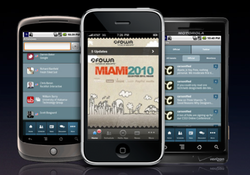|
|
 Last week I announced that the Drew McLellan iPhone and Droid apps were available. I also promised that I’d walk you through the process I went through to create the apps.
Last week I announced that the Drew McLellan iPhone and Droid apps were available. I also promised that I’d walk you through the process I went through to create the apps.
To give you the kind of detail I want to share, this is going to end up being a few blog posts, rather than one novella of a post! Today, let’s focus on who I was going to partner with to get the app done.
Exploring the options
Once I decided that I had better jump on the mobile bandwagon, I sought out Mike Sansone — who many of you may know, was my blog coach when I got started and is still my Go-To guy when I need to learn something new in the space.
I asked Mike to take me on a tour of the potential vendors and help me gauge the pros and cons of each. (A side note… there are many brilliant app designers out there but I knew I didn’t need or want something that custom. So I wanted an off the shelf solution that I could customize a bit to make it my own.)
Mike showed me the following sites:
iSites (http://isites.us): This is a new player to the space.
Pros:
- Price was right… One time $25 fee if they got to choose the ads that appeared in your app’s footer banner (all family friendly) or $99 a year if you selected the ads you’d allow.
- They’d do all the work of submission to Apple etc.
- Also would build a Droid version
- Allowed the app user to share your content via Facebook & Twitter
- With the $99 version, you could monetize your app if you wanted
Cons:
- You had to have ads on your footer banner
- They are new in the space…not a lot of feedback (good or bad) about them yet
- No push (send messages to app subscribers) yet
Mother Apps (http://www.motherapp.com/)
Pros:
- Clearly vetted — Guy Kawasaki and Chris Brogan among others use them
- Free if you allow ads (which you can share in the revenue), $99 a year for the no ad version
- They’d do all the work of submission to Apple etc.
- fast — you could have your app in the Apple Store within 7-10 days of submission
Cons:
- Not a lot of customizing can be done — pretty much your blog feed, your Twitter feed and one other option (most use YouTube it seems)
- No push (send messages to app subscribers) yet
- No Droid or Blackberry versions yet (but their site says they are coming soon)
AppMakr (http://www.appmakr.com/)
Pros:
- Lots of big names are using them (Inc., Seth Godin, AllTop)
- Very fast turnaround (Could be available in a day or two)
- $200 one time fee
- They’d do all the work of submission to Apple etc.
- Phone tech support available ($120/hour)
- Can customize the app’s tabs
Cons:
- No push (send messages to app subscribers)
- No Droid or Blackberry versions yet
Mobile Roadie (http://www.mobileroadie.com/)
Pros:
- Vetted and used by people like Dan Pink and Ashton Kutcher
- Incredibly easy interface and content management tool
- Publishes with built in multi-language support
- Has push capabilities
- Already building Droid apps too
- They do all the work of submission to Apple, Droid, etc.
- Lots of viral features — users can share your content via Facebook, Twitter, e-mail
- No ads
Cons:
- Most expensive of the bunch — $500 set up fee ($200 more if you want push)
- $29/month fee
I’m sure there are other vendors out there — these are just the ones we looked at. As I learned more about what was available, I was also able to sort out my own priorities. Here’s how they shook out:
- Ease of use — I wanted a content management system that I could handle on my own
- I wanted to be able to share more than just my blog feed and tweets
- I didn’t want to be limited to iPhone users so I wanted to publish for other platforms like the Droid
- I wanted the push functionality
- I wanted to be able to customize the navigation (both labels and order)
- I wanted users to be able to share (Facebook, Twitter etc.) my content from the app
- I wanted to be able to link to my books (with easy access to buy)
In the end, despite the higher cost — I decided on Mobile Roadie. They offered more customization and the ability for me to really include a wider variety of content in my app. But it was their content management system that really won me over.
In another post this week, I’ll give you a tour of just how easy it was for me to add content and create the look/feel of my app.

![Reblog this post [with Zemanta]](http://img.zemanta.com/reblog_e.png?x-id=c89003d3-fa80-4f63-a11a-f59e75da8e73)